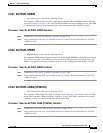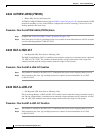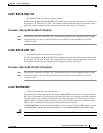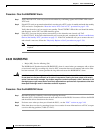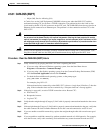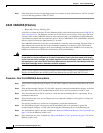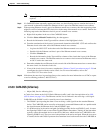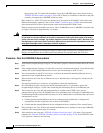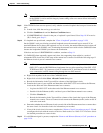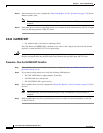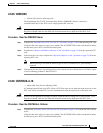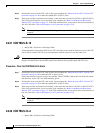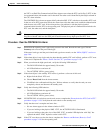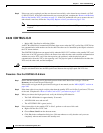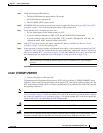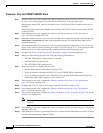
2-35
Cisco ONS 15327 Troubleshooting Guide, R3.4
March 2004
Chapter 2 Alarm Troubleshooting
Alarm Procedures
Note When the CARLOSS and the TPTFAIL alarms are reported, the reason for the condition might
be the G1000-2's end-to-end link integrity feature taking action on a remote failure indicated by
the TPTFAIL alarm.
Step 9 If the TPTFAIL alarm was not reported, verify whether a terminal loopback has been provisioned on the
port:
a. In node view, click the card to go to card view.
b. Click the Conditions tab and the Retrieve Conditions button.
c. If LPBKTERMINAL is listed for the port, a loopback is provisioned. Go to Step 10. If in service
(IS) is listed, go to Step 11.
Step 10 If a loopback was provisioned, complete the “Clear a Loopback” procedure on page 2-128.
On the G1000-2 card, provisioning a terminal loopback causes the transmit laser to turn off. If an
attached Ethernet device detects the loopback as a loss of carrier, the attached Ethernet device shuts off
the transmit laser to the G1000-2 card. Terminating the transmit laser could raise the CARLOSS alarm
because the loopbacked G1000-2 port detects the termination.
If the does not have a LPBKTERMINAL condition, continue to Step 11.
Step 11 If a CARLOSS alarm repeatedly appears and clears, the reappearing alarm might be a result of
mismatched STS circuit sizes in the setup of the manual cross-connect. Perform the following steps if
the Ethernet circuit is part of a manual cross-connect:
Note An Ethernet manual cross-connect is used when another vendors’ equipment sits between
ONS 15327s, and the OSI/TARP-based equipment does not allow tunneling of the ONS 15327
TCP/IP-based DCC. To circumvent a lack of continuous DCC, the Ethernet circuit is manually
cross connected to an STS channel riding through the non-ONS network.
a. Right-click anywhere in the row of the CARLOSS alarm.
b. Right-click or left-click the Select Affected Circuits dialog box.
c. Record the information in the Type and Size columns of the highlighted circuit.
d. Examine the layout of your network and determine which ONS 15327 and card host the Ethernet
circuit at the other end of the Ethernet manual cross-connect:
• Log into the ONS 15327 at the other end of the Ethernet manual cross-connect.
• Double-click the Ethernet (traffic) card that is part of the Ethernet manual cross-connect.
• Click the Circuits tab.
• Record the information in the Type and Size columns of the circuit that is part of the Ethernet
manual cross-connect. The cross-connect circuit connects the Ethernet (traffic) card to an OC-N
card at the same node.
e. Determine whether the two Ethernet circuits on each side of the Ethernet manual cross-connect have
the same circuit size from the circuit size information you recorded.
f. If one of the circuit sizes is incorrect, complete the “Delete a Circuit” procedure on page 2-128 and
reconfigure the circuit with the correct circuit size. Refer to the Cisco ONS 15327 Procedure Guide
for detailed procedures to create circuits.
Step 12 If a valid Ethernet signal is present, complete the “Remove and Reinsert (Reseat) a Card” procedure on
page 2-130.



